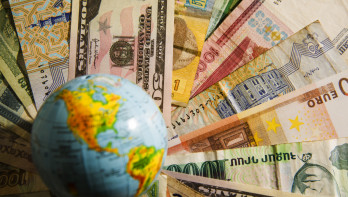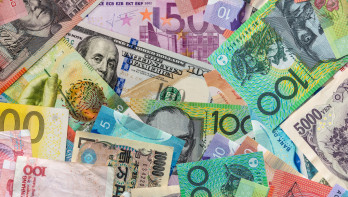Opinion Han de Jong
Take it easy with those interest rate cuts
On the conjunctural front, this year should deliver the opposite of last year. Back then, the economic growth in the US constantly exceeded expectations while the European economy stagnated. In the Netherlands, we even saw three quarters of contraction. The Chinese economy also disappointed.
But this year will be different. In China, government measures and increasing purchasing power should lead to accelerated growth. In the US, on the other hand, the direction should be reversed this year as the impetus from fiscal policy fades and the high interest rates bite harder. The mirror image is not yet unfolding convincingly, but here and there it is starting to resemble it.
The business confidence of American entrepreneurs in the industry unexpectedly weakened in May. The ISM index for the sector dropped from 49.2 in April to 48.7 in May, the lowest level in a year. The sub-index for new orders even fell from 49.1 to a meager 45.4. However, on the other hand, entrepreneurs in the service sector became more optimistic: 53.8 in May, the highest in eight months, compared to 49.4 in April.


The number of job vacancies further decreased in April. Over two years ago, there were more than twelve million unfilled job vacancies in the US, now just over eight million. The labor market is thus relaxing. This is also evident in the number of job vacancies per unemployed person. At its peak, there were two, now only 1.25. This corresponds to the pre-pandemic ratios.

The US GDP growth, finally, was a modest 1.3% in the first quarter (quarter-on-quarter, annualized), the lowest in almost two years. The Atlanta Fed GDPNow (a variable that attempts to reflect the growth pace in the current quarter in real time) for the current quarter is currently at 2.6%, but a few weeks ago it was 4%.
In Europe, we see a slightly higher growth. Here, economic growth in the first quarter was 0.3% quarter-on-quarter; annualized, just like in the US, it is 1.3%. But that European 1.3% was actually the highest quarterly growth in almost two years.
In Europe, it is not yet very convincing. Take our own country. According to CBS, the volume of household consumption in April was only 0.6% higher than a year earlier. This is not very impressive considering the improvement in purchasing power. It is not clear to me why consumption is not picking up more.

Germany is clearly the weakest link among the major countries in Europe. Especially the industry remains under pressure. In April, the volume of new orders decreased again: -0.2% compared to March. For those looking for silver linings, it can be noted that excluding 'large orders,' there was an increase of 2.9%. However, Germany has some industries where large orders make the difference. Industrial production in April decreased by 0.1% compared to March. Both order receipts and production fell short of expectations, and in the case of orders, the March figure was also revised downward.

Chinese exports unexpectedly surged in May. The export value measured in dollars was 7.6% higher than a year earlier, an improvement from the +1.5% in April. Statisticians explained the high growth rate by a base effect (May last year was a weak month) and also by stronger demand from abroad. The global pattern is nicely reflected in the geographical distribution. Chinese exports to the EU declined by 3.9%, those to the US increased by a modest 0.2%, while exports to countries in the region grew significantly. Exports to Hong Kong increased by 10.8%, to ASEAN countries by 9.7%, and to Taiwan by 8.5%.
Despite stimulating measures by the Chinese government, domestic demand remains weak. As a result, the growth of import value also remained low: +1.8% year-on-year in May. There is also a significant difference between the various regions here. Imports from the region grew strongly: Korea: 12.9%; Hong Kong 12.4%; India 11.3%; and Russia 6.9%. Imports from the US and the EU, on the other hand, decreased in value, by 5.8% and 5.6%, respectively.
As expected, the ECB lowered the interest rate by 0.25%. Remarkably, the ECB actually raised the inflation forecast. Also noteworthy is that one member of the policy committee voted against the interest rate cut. That was Robert Holzmann, the president of the Austrian central bank.
During the press conference, ECB President Christine Lagarde kept her cards close to her chest regarding any potential future interest rate moves. According to her, the ECB remains data-dependent. I predict another interest rate cut in September. By the way, the Bank of Canada also lowered the interest rate this week. The Bank of Canada was the first major central bank to do so, followed by the ECB.
I would like to add that in my opinion, inflation has certainly not been overcome yet. Earlier this week, I had the pleasure of addressing a group of entrepreneurs in Heerlen, an annual delight. When I mentioned that the logistical disruptions of the pandemic era have largely disappeared, I was rightly reminded that international freight prices have recently risen significantly again. Rising transport costs played a prominent role in the inflation surge from mid-2021.
Conclusion
I have been amazed for a while by the strength of the American economy. But cracks are starting to appear in that beautiful picture. In Europe, things are improving, but not yet for the German industry or the Dutch consumer.
Chinese exports are picking up due to stronger demand from abroad, especially from the region itself. Chinese import figures are weak as domestic economic conditions continue to falter.
The ECB, finally, lowered the interest rate, as expected. The decision was not unanimous, with only one 'dissenter.' Despite an increase in the inflation forecast, it does not seem likely that the ECB will cut interest rates again at the next meeting. Although only one member of the policy committee dissented from the interest rate cut, I believe that there is significant division within the ECB. I maintain that inflation has not yet been overcome, so I would be cautious with further interest rate cuts.

Han de Jong
© DCA Market Intelligence. Op deze marktinformatie berust auteursrecht. Het is niet toegestaan de inhoud te vermenigvuldigen, distribueren, verspreiden of tegen vergoeding beschikbaar te stellen aan derden, in welke vorm dan ook, zonder de uitdrukkelijke, schriftelijke, toestemming van DCA Market Intelligence.



